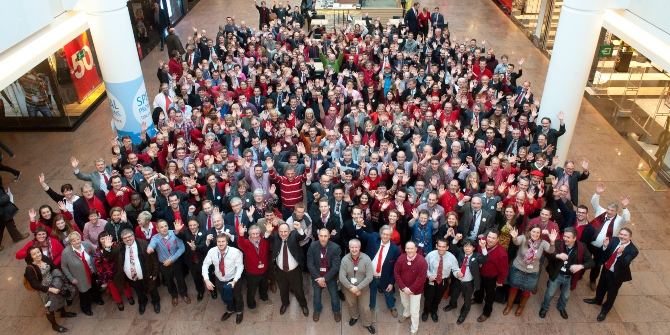
Organisational culture feeds into every aspect of organisational performance: for example the innovation of new products, competitiveness, and customer service. Yet, assessing the culture of an organisation remains a methodological challenge.
Typically, researchers have relied on employee self-report measures (interviews, surveys), yet responses to such methods are often a product of the culture itself. For example, research indicates that ‘risk-taking’ behaviours (e.g. not following protocols) by individuals within an institution can become ‘normalised’ (e.g. by nurses and doctors within healthcare institutions), meaning that when employees respond to questions about risk practices they do not see such behaviours as problematic (Dixon-Woods et al., 2008; Vaughan, 1999). This is consistent with anthropological approaches which suppose that outside perspectives are required to understand a culture. Yet, alternative approaches such as behavioural observation (e.g. actual observers, cameras, monitoring processes) are also problematic for measuring culture, because the very act of observing can have an effect on behaviour (the ‘Hawthorne’ effect: Adair, 1984).
To overcome these issues, we propose a new approach to assessing organisational culture. Namely, to tap into the informal observations of stakeholders who routinely interact with an organisation, yet are not members of it. For example, patients as stakeholders in healthcare, air traffic controllers as stakeholders in flying planes, passengers as stakeholders in public transport, and consumers as stakeholders in retail organisations.
To explore this, we have been leveraging the insights of patients in healthcare services in order to learn about the culture of hospitals. Our aim is, through analysing and aggregating complaints and compliments about experiences in hospital, to measure the culture of healthcare organisations through listening to observations of stakeholders. In the NHS there are 1 million patient episodes every 36 hours. Each of these episodes is an observation of clinical staff, administrative procedures, and the healthcare environment. Where patients and families observe or experience unsafe or poor quality healthcare, the tendency is to write a letter to the hospital to complain (with over 100,000 being received by the NHS every year). Conversely, where healthcare is exceptionally good, the tendency is to write a letter of compliment. When aggregated together (e.g. at the level of a hospital), we argue that these accounts provide an independent and non-reactive window into the functioning of organisational culture.
Our work has focused on examining this, and making sense of the complex data reported by patients and families in letters of complaint and compliment. Complaints can focus on diverse issues (from lack of WiFi to wrong-site surgery), describe different types of harm (e.g. from physical to emotional), and report on the practices of healthcare staff (e.g. attitudes, communication, competencies) (Reader, Gillespie & Roberts, 2014).
We have developed a tool to ‘metricise’ these observations in order that complaints and compliments can be used systematically to gauge the culture of healthcare organisations. Specifically, we have developed a tool called the Healthcare Complaints Analysis Tool (HCAT). HCAT is used to reliably code and analyse every complaint submitted to a healthcare organisation in terms of the problems reported within them (e.g. about safety problems, or a lack of respect to patients), and to grade their severity (e.g. a missed medication to the misdiagnosis of cancer). We then aggregate the data from each hospital (e.g. a 1000 complaints) in order to assess the culture of that institution (e.g. for managing safety). This is used to identify strengths (e.g. a lack of safety problems) and weaknesses (e.g. recurrent problems in misdiagnosis), and to benchmark hospitals.
Crucially, HCAT is built on the assumption that external stakeholders are able to identify and honestly report on practices within an organisation, and that when these observations are systematically analysed and aggregated, they can be used as an alternative metric of organisational culture. Our guiding insight is the idea that sometimes people who are outside the organisation, but also dependent upon it, have insights into the organisational culture that are invisible to those embedded within that culture.
♣♣♣
Notes:
- This post is based on the authors’ paper The Healthcare Complaints Analysis Tool: development and reliability testing of a method for service monitoring and organisational learning, BMJ Quality and Safety, 2015, 004596v2
- This post gives the views of its authors, not the position of LSE Business Review or the London School of Economics.
- Featured image Meeting our midwife by Salim Fadhley, under a CC-BY-SA-2.0 licence
 Tom Reader is an Assistant Professor in Organisational and Social Psychology at LSE. He is director of the MSc in Organisational and Social Psychology and leads a teaching module on Organisational and Social Decision-Making. Dr Reader’s research examines how social psychological processes (e.g. behaviours, belief systems) in groups and organisations develop and influence the management of risk in complex socio-technical industries (e.g. aviation, healthcare, financial trading, energy).
Tom Reader is an Assistant Professor in Organisational and Social Psychology at LSE. He is director of the MSc in Organisational and Social Psychology and leads a teaching module on Organisational and Social Decision-Making. Dr Reader’s research examines how social psychological processes (e.g. behaviours, belief systems) in groups and organisations develop and influence the management of risk in complex socio-technical industries (e.g. aviation, healthcare, financial trading, energy).
 Alex Gillespie is Associate Professor in Social Psychology at LSE, and an Editor of Journal for the Theory of Social Behaviour. He is an expert in cultural psychology, focusing on trust, communication, and misunderstanding. His work aims to develop useful methods, tools and interventions.
Alex Gillespie is Associate Professor in Social Psychology at LSE, and an Editor of Journal for the Theory of Social Behaviour. He is an expert in cultural psychology, focusing on trust, communication, and misunderstanding. His work aims to develop useful methods, tools and interventions.





